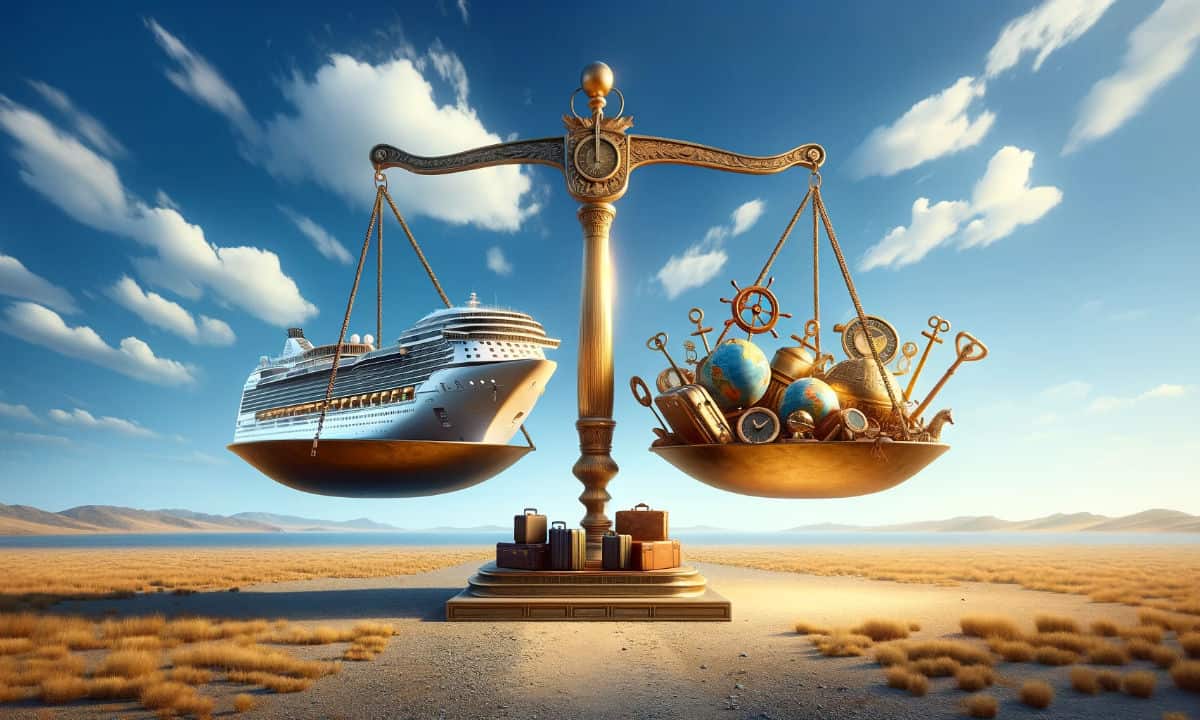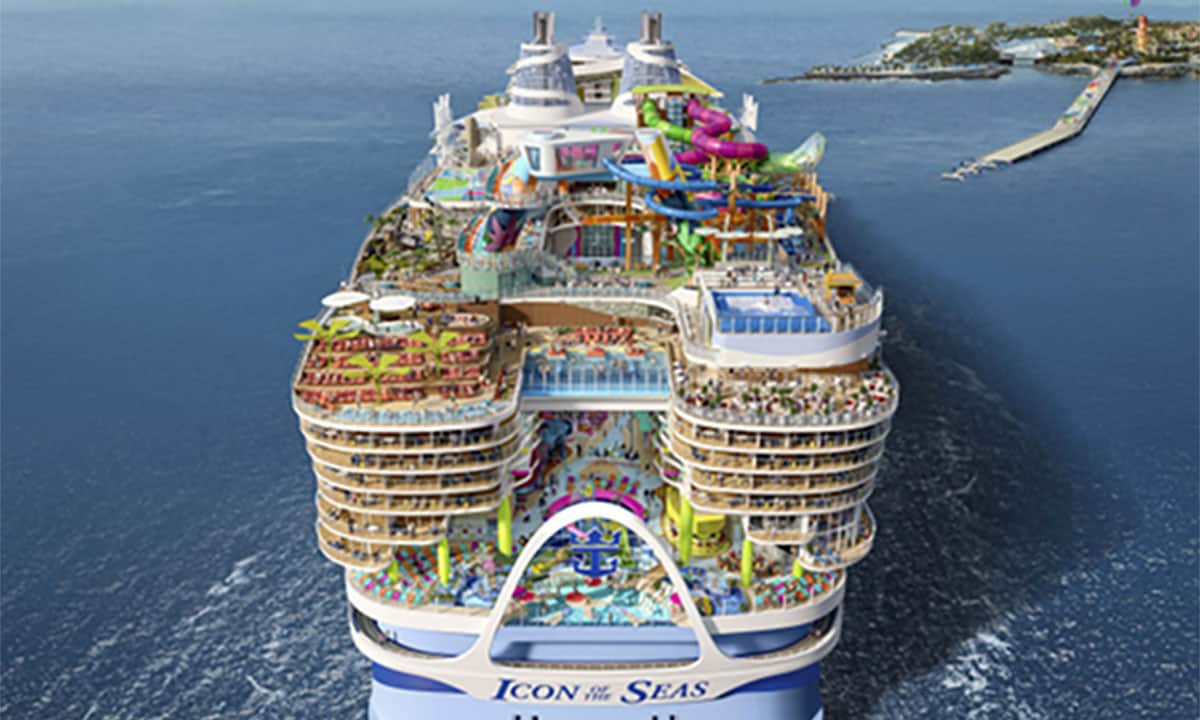How much does a cruise ship weigh in tons? Now if you are anything like a cruise junkie like me, these are the types of questions that keep me up at night LOL
The standard size of a cruise ship just seems to be getting bigger and bigger? With the ability to carry thousands of passengers, the enormity of these massive vessels can be mind-boggling.
In this article, we’ll dive into the world of cruise ship construction and explore the factors affecting their weight to give you a better understanding of what these colossal vessels actually weigh.
Now one man’s cruise ship is another’s private yacht, so just to be clear that what we are discussing here are the multi-passenger cruise ships that you are likely to be seeing sailing out of the Port of Miami every day of the week.
So let’s get started.
How Much Does a Ship Weigh? Let’s Find Out
Measuring the Weight of Cruise Ships

Tonnage and Measurement Standards When You Weigh A Cruise Ship
When talking about the weight of a cruise ship, the term you’ll most often come across is gross registered tonnage or GRT. You might think this refers to the ship’s overall weight, but actually, gross tonnage is a measure of a ship’s volume or enclosed space, not its actual weight.
This is different from other measurements like deadweight tonnage, which refers to the weight a ship is carrying, including cargo, fuel, and of course the weight of passengers and crew members.
To calculate gross tonnage, you’ll take into account the size of the ship, including the total enclosed spaces, and it gives a good indication of a ship’s overall passenger capacity. This standard measurement helps in comparing different ships and their sizes.
The Significance of Gross Tonnage As a Measure of Weight of a Modern Cruise Ship
If you are new to cruising, you may wonder why gross tonnage matters when you’re planning your next cruise ship vacation.
Well, the reason is that larger ships with higher gross tonnage often provide a more extensive range of amenities, entertainment options, and space for you to enjoy. They are also more stable and can handle rougher seas.

To get an idea of how cruise ship sizes have evolved here are some key moments in the development of cruise ships from the major cruise lines in the past Century or so:
- RMS Titanic: This historic ship measured around 46,328 tons and was the largest ship in the World when launched on it’s ill-fated voyage in 1912.
- RMS Queen Elizabeth: At 83,673 Gross Tons, this ship held the record for the largest ship from 1940 all the way through to 1972 when it was destroyed by fire. It wouldn’t be until 1996 that a larger ship was built.
- Sovereign of the Seas: Launched in 1987 and weighing in at 73,529 Gross Tons, This became the first of the “modern” “mega” cruise liners and put Royal Caribbean on the map.
- Carnival Cruise Line’s Destiny (aka Carnival Sunshine): This ship was the first to break the Queen Elizabeth record and surpass 100,000 tons – 101,353
- Freedom of the Seas: Launched in 2006, the 154,407 GT Freedom of the Seas had now doubled the size of their first “mega” ship, and was able to accommodate a vast number of passengers compared to the Sovereign of the Seas.
- The World’s Largest Cruise Ship: This is the Icon of the Seas which is a whopping 250,800 gross tons and almost 1200 foot in length and 160 feet wide.
Nowadays I would think of cruise ships and their gross tonnages in these categories.
- Small cruise ships: 10,000 – 80,000 gross tons
- Mid-Size cruise ships: 80,000 – 130,000 gross tons
- Large cruise ships: 130,000 – 180,000 gross tons
- Mega cruise ships like the Oasis of the Seas have a range of 180,000 – 260,000 gross tons.
As you can see, there is quite a range of gross tonnages when it comes to cruise ships.
How Heavy Are The Largest Cruise Ships in the World
Leading Cruise Lines and Their Heaviest Cruise Ships
When it comes to the heaviest cruise ships in the world, Royal Caribbean International takes the crown with its stunning new ship, the Icon of the Seas.

This massive ship boasts a gross tonnage of 250,800 making it the largest and heaviest in the world to date.
To put that into perspective, the historic Titanic weighed a mere 46,328 gross tons, less than a quarter of the gross tonnage of larger cruise ships such as Quantum of the Seas. That’s quite a difference!
As a matter of fact, Royal Caribbean International holds the title for the top three largest cruise ships in the world, with their Wonder of the Seas and Symphony of the Seas closely following the Icon of the Seas.
How Cruise Ship Weight Impacts Ship Amenities and Passenger Experience
As you step aboard one of these massive cruise ships, you’ll quickly notice that their size has allowed for some truly amazing amenities.

These amazing ships like the Harmony of the Seas and its sister ship the Allure of the Seas can host thousands of guests. The ships provide an incredible range of experiences. Depending on its size, a typical large cruise ship might now include such amenities as:
- Multiple swimming pools including Surf-simulators
- Water park slides that would put Orlando’s best to shame
- State-of-the-art theaters
- Shopping centers that match your local Mall
- And even ice-skating rinks, roller coaster rides and even bumper cars!
Vessel Buoyancy and Stability
Now, if you are curious like me, you might wonder: how do these cruise ships that weigh hundreds of thousands of tons manage to stay afloat despite their incredible weight?
It all comes down to the principle of buoyancy.
Essentially, the sheer size of their gigantic hulls is designed to displace a large volume of water, creating an upward force that counteracts the ship’s weight.
And cruise ships are designed to be super-safe! This includes larger cruise ships like Oasis of the Seas. The design and engineering features of cruise ships have come a long way since the days of the Titanic.
Innovations in hull design, compartmentalization, and materials have not only allowed these ships to float but also to maintain balance as they sail the open seas.
However, with great size comes great challenges and risks. Factors such as stability, agility, and fuel efficiency become more complex as the size and weight of the ship increases. Not to mention the potential environmental impacts and difficulty navigating narrow waterways or docking at smaller ports.
In conclusion, the heaviest cruise ships in the world are truly engineering marvels, offering unrivaled amenities and experiences for their passengers.
[Related Article: How Much Of a Cruise Ship Is Under Water?]
The Incredible Modern Engineering Behind The Heaviest Cruise Ships
Now let’s talk about the challenges and risks associated with the weight and size of these colossal vessels. It’s no surprise that the scale of these floating cities poses a few challenges for engineers and operators:
Maneuverability
Steering these mega ships in docks and tight port locations is like trying to parallel park a bus in a compact car space – tricky, to say the least.
So, engineers came up with a brilliant solution: Azipods.
Think of Azipods as gigantic outboard motors that can swivel around like an owl’s head. This gives the captain the flexibility to move the ship in any direction – forward, backward, sideways, you name it!
Also, there are bow thrusters, which are like little power boosters that help push the nose of the ship around. It’s like having a group of strong tugboats pushing the ship to help it turn. Ingenious!
Fuel Consumption
Fuel consumption is a biggie.
These ships gulp fuel like a parched camel at an oasis. Engineers had to get creative to tackle this. One solution is using more efficient hull designs.
Think of it as shaping the ship to cut through the water like a hot knife through butter. Less resistance means less fuel is needed.
Also, there’s a move towards alternative fuels, like liquefied natural gas (LNG), which is cleaner more efficient, and better for the environment
Storms and rough seas
Sailing through a storm on a mega cruise ship can feel like riding a roller coaster. Although the sheer height of the ship will tower above the waves, the ship will still rock and roll. Ironically though, it’s important to note that the smaller the ship is, the more noticeable the roll!
To keep the thousands of passengers and crew from getting sea sick on these large cruise ships, engineers have created stabilizers – think of them as giant underwater wings.
These wings extend from the sides of the ship under the water and move to counteract the side-to-side rolling caused by waves. It’s like having a balancing arm that keeps you from toppling over while walking on a tightrope.
Plus, cruise ships are equipped with modern navigation and weather forecasting tools that allow Cruise Ship Captains of even the largest cruise ships to plot courses that avoid the worst of the weather.
In summary, these engineering breakthroughs make cruising on these mega ships not just possible, but also enjoyable.
Navigating tight spaces, using less fuel, and keeping steady on the high seas – it’s all in a day’s work for these floating wonders. Remember, it’s not just the size that counts, but the clever tricks up their massive sleeves!
How Much Does a Cruise Ship Weigh? Now You Know
So, there you have it. Modern cruise ships are impressive structures, but despite their massive weight they can still float without any issues and carry lots of fun stuff like pools, slides, and theaters.
So the next time someone tells you that Titanic was the biggest cruise ship ever made, you can correct them by telling them it’s dwarfed by even the smaller ships now. Then you can look even smarter by telling them the biggest and heaviest ship ever made is the Icon of the Seas and it weighs over five times heavier!
The cruise industry has come a long way in just over a 100 year, with some incredible advances in the past couple of decades. Who knows what we’ll see next!